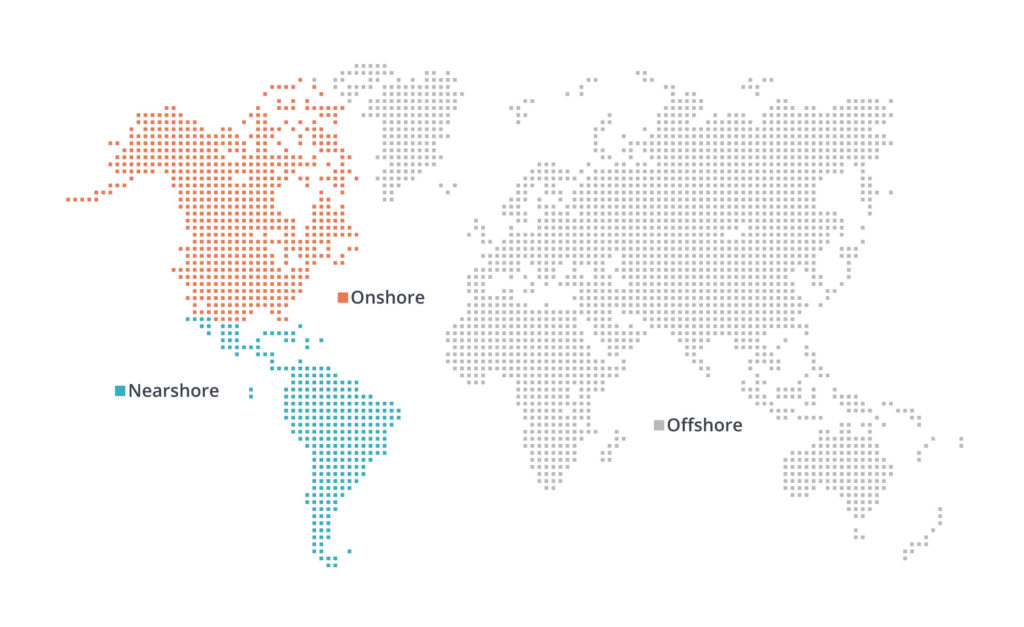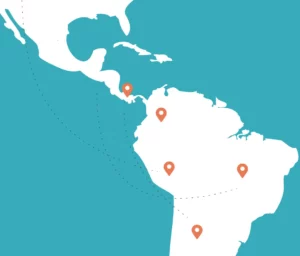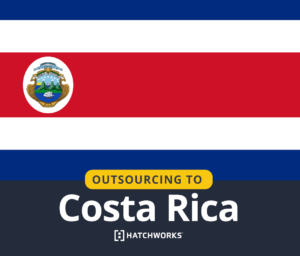Nearshore software development is an ideal way to get the talent you need at a price you can afford.
Luckily, we’re living in the golden age where teams have proven they can be productive and collaborative in a remote environment, dare we say more productive.

- The definition of Nearshore software development
- The different types of software outsourcing
- How Nearshore software outsourcing works
- How costs compare between Nearshore, Onshore, and Offshore development
- The benefits of Nearshore software development
- The differences between Nearshore and Offshore
- Where to Nearshore in Latin America
- Frequently Asked Questions about Nearshore Software Outsourcing
- HatchWorks Nearshore Software Development Services
What is Nearshore software development?
Nearshore software development is when a company has distributed teams in countries that are in the same or similar time zone. In the US this means countries in Latin America.
Clutch reports that 90% of small businesses plan to outsource business functions, including IT and software projects, in 2022. 21% of those small businesses outsourcing tasks in 2022 intend to hire a Nearshore outsourcing company, up from 15% in 2021.
In this complete guide, we share everything about the Nearshore software development model from how it works to the types of projects best suited for this type of software outsourcing. We’ll explore the pros and cons of Nearshore software development services and other alternatives, so you can decide if this model works and will help you meet your business objectives.
What are the types of software outsourcing?
The three types of software outsourcing are Onshore, Offshore, and Nearshore.

Onshore
Onshore development means hiring software developers in the same country or region your company resides. It is usually the most expensive option of the three outsourcing model types, especially if you are in the US.
An increased need for digital transformation has created an unprecedented shortage of top talent, especially in the US market. Gartner reports increases in job openings, turnover, time to fill open positions, and salary expectations.
Projects best suited for an in house team or Onshore outsourcing
- Those requiring frequent in-person collaboration
- Those with data privacy restrictions in terms of where developers are located
- Those where there are physical elements of the solution that require in-person development like IoT sensors and other smart machines
Offshore
Offshore software outsourcing is when you hire a vendor in a distant country to handle development, typically used with countries in Eastern Europe or Asia, such as China, or India.
If you are seeking the option with the most cost effectiveness, offshoring is potentially the way to go. However, it does come with tradeoffs and hidden costs.
While language barriers are increasingly becoming less of an issue, there are other considerations to keep in mind.
The greatest challenges of Offshore development are the time zone difference, high turnover, and cultural differences. These factors can create barriers to communication and negatively impact the velocity of your team.
You can mitigate these issues by having your offshore team work during the night so you can share the day’s work and have smooth communication. However, developers and project managers in countries like India now have a choice of where they work given large corporations and local companies setting up shops in India to attract the best talent.
Projects best suited for Offshore development:
- Non-automated processes requiring repetitive tasks
- IT support projects
Less strategic ambiguous projects - Projects that don’t require high collaboration and Agile process
- Projects not as impacted by high turnover
Nearshore
Nearshore is an outsourcing model where your custom software development needs are fulfilled by distributed teams located in a nearby country within the same continent or within the same or similar time zone.
For business leaders in the United States, this means outsourcing your product development needs to a Nearshore software development company in Latin America; whereas Western European countries outsource to nearby countries in Eastern Europe, like Poland or Ukraine.
Unlike Offshore outsourcing, you won’t lose sleep Nearshoring software development. Their time zones and cultural similarities make for easy collaboration while the close proximity allows for more affordable face-to-face encounters.
Increasingly favorable attitudes towards remote work following the Covid pandemic have allowed many companies to integrate their in-house teams with distributed workers from a much larger talent pool in Latin America.
Projects best suited for Nearshore software development companies:
- B2B, B2C, and SaaS Solutions
- Those requiring real-time collaboration, but not necessarily face-to-face
- Those leveraging an Agile approach
- Strategic and more ambiguous projects that require real-time discovery and collaboration
- Development of new software solutions
- Modernization of complex legacy software solutions
How Nearshore software outsourcing works
Nearshore software development allows you to expand your access to development teams in nearby countries while maintaining your ability to share the days work with your team. Nearshore software development companies function as a conduit for you to access resources outside of your immediate geographical proximity. These types of development partners manage and oversee teams throughout Latin America, ensuring smooth communication, efficient workflows, and cultural understanding. Nearshore software outsourcing companies based in the US typically offer Errors and Omissions (E&O) Insurance, providing risk management systems that are not necessarily common in Latin America. This type of insurance provides you with both the protection you require and the peace of mind you need to focus on your project. Want to know more about the development process? When outsourcing software development services, there are three standard outsourcing models to choose from. There are benefits to each, and the availability of each will depend on the partner you choose. Staff Augmentation: Integrating Nearshore Software Developers into Your Team
Staff Augmentation: Integrating Nearshore Software Developers into Your Team
Staff Augmentation is best when you are looking to fill gaps within your own team. Your internal team works alongside your partner’s software engineers in the same or similar time zone.
You are typically required to provide direction for your partner’s engineers, and you own the outcome of the project. Contracts are often structured in a time and materials or fixed monthly cost per team member.
This service allows you to easily expand your talent footprint, tapping into talent-rich areas of Latin America. The most significant consideration in this model is selecting a software development company with exemplary hiring processes to ensure you bring the right people on board.

Dedicated Agile Teams
Dedicated Agile Teams teams provide you with a turn-key, well-oiled, development machine.
You benefit from your Nearshore company’s experience delivering projects as a team, thereby providing built-in velocity from the very start of your project.
The concept of bringing work to teams is a hallmark of creating a zen-like Agile development team.
The team is selected based on your unique project requirements with the major benefit being the turn-key nature of a dedicated team. You can go from 0-60 without requiring the need to bring any of your own resources to the plate, or more importantly disrupt your key resources from other critical projects.
These contracts are typically structured in a fixed monthly price for the entire team making budgeting for your project easy. It is also common to see these types of engagements structured in an outcome-based model since your partner’s team is working in a more autonomous nature focused on delivering the value you desire.
At the end of the day, dedicated teams typically provide a more consistent experience, with a shorter time to value, and the ability to easily scale up and spawn new teams.

Outcome-Based Projects
These projects are designed with a focus on achieving specific business objectives. Given the autonomous nature of the partner’s team, there’s a strong emphasis on delivering the desired value.
Ultimately, Outcome-Based Projects offer a more consistent experience, ensuring quicker value realization and the flexibility to efficiently scale and initiate new teams as needed.
Nearshore software outsourcing costs compared
Developers in India and China offer the lowest hourly rates. Despite that, Nearshore software developers still provide substantial savings compared to Onshore options.| Feature | Onshore | Nearshore | Offshore |
|---|---|---|---|
Architect | $140 - $190 | $72 - $96 | $47 - $95 |
Business Analyst | $110 - $154 | $54 - $68 | $31 - $81 |
Scrum Master | $120 - $153 | $50 - $79 | $44 - $74 |
UX/UI Designer | $85 - $130 | $48 - $75 | $29 - $71 |
DevOps | $114 - $148 | $59 - $82 | $29 - $79 |
Lead Developer | $160 - $210 | $66 - $82 | $41 - $82 |
Associate Developer | $80 - $120 | $41 - $53 | $21 - $53 |
Mid Level Developer | $120 - $150 | $53 - $66 | $27 - $65 |
Senior Developer | $145 - $175 | $65 - $82 | $34 - $76 |
Associate QA Engineer (Manual) | $65 - $100 | $34 - $52 | $18 - $44 |
Mid Level QA Engineer (Manual) | $100 - $126 | $42 - $59 | $22 - $59 |
Senior QA Engineer (Manual) | $115 - $139 | $53 - $66 | $25 - $61 |
Associate QA Engineer (Automated) | $74 - $120 | $35 - $55 | $22 - $51 |
Mid Level QA Engineer (Automated) | $125 - $151 | $48 - $62 | $25 - $63 |
Senior QA Engineer (Automated) | $140 - $167 | $59 - $72 | $29 - $74 |
Nearshore software development outsourcing benefits
There are many advantages to the Nearshore software development model in Latin America.

Real Time Collaboration
The most obvious advantage of working with Nearshore software development teams is that they are in the same time zone as your business.
Sharing of the day’s work cycle is an important factor to consider when you Nearshore to Latin America. Collaboration is done in real-time, avoiding the typical 1-day lag you see with offshoring software development.
In today’s Agile world, you can’t afford to have a 1-day lag. Otherwise, the competition will eat your lunch.
It’s also easier to book flights for face-to-face meetings with Nearshore software development companies than with an Offshore software development company in India. A flight from Atlanta, Georgia to San José, Costa Rica is about as long as a flight to San Jose, California.
Latin America is a Fast-Growing Region
Latin America is a fast-growing region whose economies are expanding at a steady rate. The world has turned its attention to the region because of the economic and political climate in Europe. Latin America has become an increasingly rewarding location for Nearshoring.
A larger talent pool of top developers
The demand for developers globally has been on the rise and is expected to continue in the future. However, there is a scarcity of qualified developers in the US.
But when it comes to finding top talent for your software development needs, location doesn’t matter, talent does. In Latin America, there is a larger talent pool of top-notch Nearshore developers ready to work on your project.
Cultural alignment and English language proficiency
Cultural between the US and Latin America is another important factor to consider when you Nearshore. Throughout Latin America, most speak Spanish as their first language, but a majority of the population also speaks English.
Language and cultural barriers are less pronounced compared to Offshore. When you work with Nearshore developers in Latin America, the alignment is much stronger creating a more cohesive team and experience.
More affordable than Onshore
Because Nearshore is more affordable than Onshore outsourcing model, it is often your best choice when your budget is top of mind. Although it is slightly more expensive than Offshore, Nearshore will often give you more value for your investment.
If you want the advantages of Onshore without the drawbacks of Offshore, then Nearshore is your best option.
Nearshore is a smart move for companies that are focused on increasing their velocity and getting more value for their money. Latin America has many advantages, including a larger talent pool of top Nearshore developers, a time zone alignment with North America, cultural similarities with the US, and English language proficiency.
Nearshore and Offshore differences explained
| Nearshore development | Offshore development | |
|---|---|---|
Real-time collaboration | Same or similar time zone | 5-12 hour time zone difference |
Cultural affinity | Very similar work culture and practice, less cultural differences | Not as similar, more cultural differences |
English language proficiency | Moderate to low proficiency across Latin America | Wide range from Very Low to High across Europe and Asia |
Travel accessibility | 2-5 hour flights, less complicated than traveling to Europe or Asia | 8+ hour flights, plus an increased need for overnight accommodations |
Project security | Increased likelihood of shared or similar data protection laws | Not likely to share data protection laws |
Project costs | $25-50/hour | $15-100/hour |
Cost savings | Not as pricey as Onshore | Affordable but hard to manage |
Quality | Equal or great quality to Onshore | Lower quality than Onshore |
Risks | Medium risk | High risk |
For a deeper dive into the differences between the two, check out our Comprehensive Comparison of Nearshore vs. Offshore Software Outsourcing.

Where to Nearshore in Latin America
Latin America is a popular destination for a Nearshore development center due to its proximity to the United States, as well as its strong pool of talented software engineers and favorable time zone.
According to a report by Deloitte, “major international employers—including global technology, retail and consumer goods, banking, manufacturing, and automotive companies—take action to establish an engineering presence in LATAM markets such as Mexico, Colombia, Costa Rica, and Brazil.” This further emphasizes the region’s growing significance in the global software development landscape.
Argentina
Argentina has a well-developed software development industry, with a strong focus on export markets. The country has a highly educated workforce and is home to a number of globally recognized tech companies, including MercadoLibre and Despegar. Argentina has a long tradition of excellence in computer science and engineering, and the country has a strong reputation for producing high-quality software professionals. Argentina is known for its strong culture of innovation and entrepreneurship, and there is a vibrant startup ecosystem in the country.Brazil
Brazil is the largest and most populous country in Latin America, and it has a thriving software development industry. The country is home to a number of globally recognized tech companies, including StoneCo and Movile, and it has a large pool of talented professionals. Brazil’s favorable time zone and cultural compatibility with the United States make it an attractive Nearshore destination for companies in North America.
Chile
In 2021, Chile‘s dynamic IT industry made up 2.7% of its national GDP, showcasing its swift tech progression. As per the International Trade Administration‘s findings, Chile leads in internet usage across Latin America. Their ambitious “Chile Digital 2035” project underscores their commitment to a digital future. Statista points out that Chile’s software realm ranges from basic applications to intricate enterprise systems, with major players like Microsoft and Adobe in the mix. Given its geographical advantage, Chile emerges as a top choice for Nearshore software ventures.
Colombia
Colombia has a strong ecosystem of universities and research institutions that support the software development industry. The country has a number of universities that offer programs in computer science and related fields, and there are a number of research institutions and centers of excellence focused on software development and related technologies.
Costa Rica
Costa Rica is a small but developed country in Central America with a growing software development industry. The country has a highly educated workforce, with a high percentage of the population holding university degrees. Costa Rica also has a strong tradition of entrepreneurship and innovation, and it has a number of successful tech startups. Costa Rica is also known for its cultural compatibility with the United States, which can facilitate better communication and collaboration between teams.
Mexico
Positioned adjacent to the US, Mexico shines in Nearshore software development. With a rich tech talent pool, it’s a magnet for global enterprises. It’s a top IT exporter, with exports over $21B. Renowned hubs like Guadalajara and Mexico City house both startups and tech giants. The government’s push, including IT hubs and the USMCA’s digital focus, strengthens its IT allure and draws international investments.
Peru
Peru is a prominent software outsourcing destination in Latin America and is performing well in the industry. Its economy has demonstrated strong growth and recovery post-pandemic. The country boasts top-ranked universities, a thriving startup culture, and highly skilled and educated developers. The Peruvian government is actively investing in technology development, attracting multinational tech companies to establish offices in the country.
Uruguay
Uruguay is a small but developed country with a growing software development industry. The country has a highly educated workforce and a business-friendly environment. The country has a number of universities that offer programs in computer science and related fields, and there are a number of research institutions and centers of excellence focused on software development and related technologies.
Want to learn more about the top Nearshore software development destinations in Latin America? Check out the Top Latin American Countries for Nearshore Software Development in 2023.
Frequently Asked Questions about Nearshore Software Outsourcing
Nearshore development offers scalability by allowing businesses to quickly ramp up their development capabilities without the need for extensive in-house hiring. It provides flexibility in managing project scope and resources, adapting to changing market demands, and ensuring continuous delivery of high-quality software solutions.
HatchWorks Nearshore Software Development Services

HatchWorks is a US-based Nearshore software development partner that combines local, high-touch service with the affordability and scale of Nearshore outsourcing, all in your time zone.
Our teams are fluent in English and have a 98.5% retention rate—meaning your project won’t be interrupted or delayed.
After a 5-step screening process, we fit you with the right talent for the job and build your digital products one of three ways: through Staff Augmentation, Dedicated Agile Teams, or Outcome-Based Projects (a full service solution).




